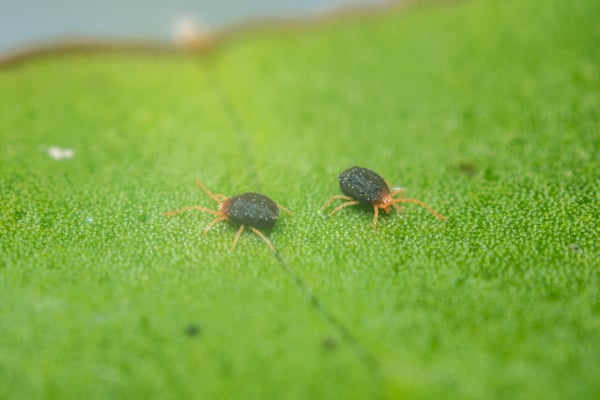Clover Mite

This species of mite loves infesting clover plants. Clover mites (Bryobia praetiosa) are considered a nuisance pest. They occasionally invade structures by the thousands, primarily in the spring and autumn. Clover mites are distributed worldwide and found throughout the US.
BEHAVIOR
Clover mites are plant feeders only. They feed on about 200 different plant species including trees, shrubs, flowers, grass, and agricultural or garden crops. White clover and black medic are Clover mites’ most-preferred host plants. They’re also fond of Kentucky bluegrass, bent grass, red fescue, redtop, and chickweed. Around structures, they show a preference for heavily fertilized grass lawns. The mites sometimes leave their spherical red eggs on foundation walls, foundation cracks, or vegetation. In spring and fall, clover mites may lay so many eggs that they’ll completely cover infested surfaces.
Clover mites tend to invade structures during the first warm, sunny days of spring after rain showers. They may often infest structures again in autumn as vegetation dies. In autumn, hundreds of thousands of clover mites may attempt to move into buildings. They generally try to get in through cracks around windows and doors or through masonry cracks. They creep behind siding until they can find an entry point. Clover mites are active during times of cooler weather and become dormant during hot weather.
CONTROL AND PREVENTION
An 18”, grass-free band around your structure’s perimeter could reduce the number of clover mite invaders you have to deal with by 90%. Combining this vegetation-free perimeter with a professionally-applied pesticide perimeter treatment will help prevent clover mites entirely.
If you find clover mites inside, you should only remove them using a vacuum cleaner with a hose attachment. Don’t attempt to crush or wipe them away, or they’ll leave behind red stains and smears.
APPEARANCE
Adult clover mites are 1/64” long and have a soft, oval body. They’re usually dark red, olive green, or rusty brown in color. Except for hatchlings, (which have 3 pairs of legs) clover mites have 4 pairs of legs. The first pair of these legs is about twice the length of the 2nd pair. The mites hold these legs forward like antennae. Clover mites are exclusively plant feeders. Immature, developing stages are bright red in color.
PROFESSIONAL CONTROL
Plunkett’s professionals treat for clover mites by applying a residual insecticide spray around the perimeter of your structure. We apply this spray in a band extending 2 feet up and 6-10 feet out from the structure’s foundation. It’s very important that we apply this treatment in late March or early April to maximize its effectiveness. We’ll also vacuum up clover mites inside to prevent them from smearing. In some cases, we may also apply indoor crack and crevice pesticides.
If you think you have clover mites, give Plunkett’s a call any time. We can identify your problem and figure out the best way to stop it. When we’re done, you won’t have to worry about a single clover mite getting inside–no matter how many might want to!







